Berlin (dpa) – While many who menstruate still struggle to talk openly about it today due to enduring taboos, people at the end of the 19th century may have not hesitated as much.

In the absence of menstrual products, blood simply ended up on sheets and clothes, which were then removed in public washing places for all to see, an exhibit at Berlin’s Museum of European Cultures explains.
Dubbed «Flow: The Exhibition on Menstruation,» the show takes us back to the beginning of the 20th century, when the first prototypes for today’s menstrual products began to emerge.
DIY instructions to sew «undergarnments for special days» – large baggy frocks that included a removable pad – were circulated in magazines and some models are available to try out at the museum, but strapping them on is no easy task.
Sanitary towels continued to dominate over the decades – before the invention of adhesive wings, they were usually hooked to a so-called sanitary belt worn underneath the clothes to keep them in place.
However, other products such as the menstrual cup were actually developed as early as 1937 by female doctors and entrepreneurs but initially failed to take off.
Besides the very tangible aspect of period hygiene – you are invited to touch menstrual sponges, cups and tampons – the exhibit also delves into scientific research, contemporary discourse and pop art, challenging you to consider how we’d think about menstruation if it were men who menstruate.
Was Gloria Steinem right to surmise in an 1978 essay on «menstruation,» also on display, that «men would brag about how long and how much,» and «sanitary supplies would be federally funded and free»?
A collage of all things blood that includes nearly 200 exhibits, «Flow» challenges us to reconsider our conception of menstruation, focusing «on the experiences and voices of menstruators.»
Fittingly, the exhibit ends with an invitation to sit down and share your period story on a piece of cardboard paper.
As roughly 2 billion people in the world menstruate and another 1.5 billion have had or will have their periods, according to the curators, it should come as no surprise that people have a lot to say. The exhibit runs until October 6, 2024. General admission is €8.

